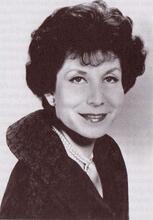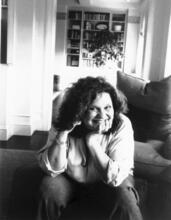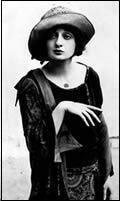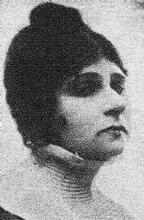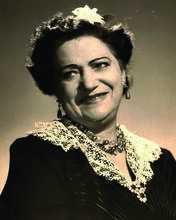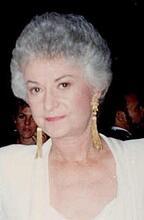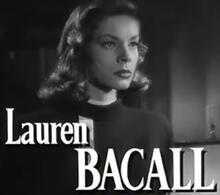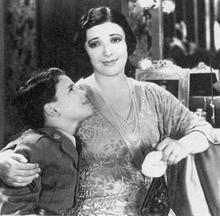Ladino (Judeo-Spanish) Theater in the United States
The Judeo-Spanish theater traces its origins to Turkey and the lands of the Balkans, where women participated as actors, directors, and playwrights. The role of women in the Ladino theater is an eloquent testimony to how they have contributed to their communities, responded to national crises, and lent their energies to the continuation of the Judeo-Spanish cultural and linguistic heritage. Perhaps the most extraordinary example of the female role in the American Judeo-Spanish theater is Esther Cohen, who wrote and performed plays in Brooklyn in the 1930s. Cohen’s contributions to Ladino drama were chronicled in the Judeo-Spanish newspaper, La Vara. American Ladino theater has been resurrected in New York by The Ladino Players, a troupe founded in 1994, whose cast is roughly half female.
Introduction
The Judeo-Spanish theater traces its origins to Turkey and the lands of the Balkans, where women participated as actors, directors, and playwrights. In the Old Country, female Ladino playwrights were sometimes prolific, though uncommon. Spanish scholar Elena Romero has identified three of these dramatists active in the late nineteenth and early twentieth centuries: Elda Moriano of Salonika, Roza Moïse Gabay of Constantinople, and especially Laura (Bohoreta) Papo of Sarajevo, who wrote numerous dramas and comedies enlivened with romansas (traditional Judeo-Spanish ballads) and dances. Mirroring their sisters in the Orient, women in the United States were also active in the Ladino theater as both performers and dramatists. The American Judeo-Spanish press, which appeared almost exclusively in New York from 1910 to 1948, is perhaps the best source for documenting the role of women in the Ladino theater. The press is a rich source for both announcements of upcoming performances and critical reviews, often providing the names of individual actors, a description of their roles, and a commentary on the quality of their performances. While most of these reports were positive, reviewers exhibited little hesitancy in openly criticizing poor acting. Generally, drama groups readily cast females in their productions, although occasionally female roles were interpreted by male actors.
Judeo-Spanish Theater in New York
On the Lower East Side, where some twenty thousand Ladino-speaking immigrants resided by the early decades of the twentieth century, Ladino drama troupes, formed by Sephardic drama clubs and political and social organizations, served numerous functions. These groups provided social activities for both performers and audience members, and the resulting production was sometimes followed by a lively ball lasting until the early hours of the morning. Judeo-Spanish performances brought every sector of the community together: men and women, adults and children. They were means through which Descendants of the Jews who lived in Spain and Portugal before the explusion of 1492; primarily Jews of N. Africa, Italy, the Middle East and the Balkans.Sephardim could express political and social activism, since many shows donated their proceeds to local Sephardic clubs, to both local and overseas charities, and to the victims of the two world wars. Performances sometimes attracted huge audiences of one to two thousand people. This figure is particularly outstanding considering that the Judeo-Spanish theater of the United States was by definition communal, and never achieved professional status. (The performances of such troupes as the Association of Sephardic Actors, organized in February of 1917, were of such high quality that an editorial in La Luz [The light] of 1922 encouraged the association and other Ladino drama groups to form professional theatrical companies, a suggestion that, regrettably, went unheeded.) Perhaps the most important reason for the vibrancy of the Ladino theater in the kolonia, as Sephardic immigrants referred to their community, was that it often combined social idealism with lively entertainment.
Productions
The earliest dramas performed in the United States in Judeo-Spanish were most likely plays sponsored by communal organizations. In terms of genre, Judeo-Spanish drama ranged widely, encompassing religious, historical, and original themes. Plays such as the Hebrew drama Love and War, also known as Yehuda Makabi [Judah the Maccabee], were historical in nature, while works such as Ataliahu, also known as El Koronamiento del Rey Yoash [The Coronation of King Yoash], focused on biblical themes. Several plays were original in theme and composition, such as Margarita, a three-act love story written by the founder and editor of the socialist Ladino newspaper El Progreso [Progress], Maurice S. Nessim, and serialized in his tabloid in 1915. Based on a selective reading of the Ladino press, perhaps the majority of Judeo-Spanish plays performed in America represent Jewish and non-Jewish dramas translated from other languages into Judeo-Spanish, while a minority of performances are original works composed by Ladino playwrights of the Old Country and the United States. Among the translated dramas performed by Ladino theater groups were European literary classics, such as Romeo and Juliet (translated by Alberto Halfón, a former actor in the national theater of Sofia, Bulgaria) and the works of Molière. Ladino scripts, translated from the Hebrew and Yiddish, were available for sale to Ladino societies at the editorial offices of La Amérika, and that newspaper actively solicited acquisitions of Judeo-Spanish plays in both published and manuscript form.
One of the earliest American Judeo-Spanish productions was Ahashverosh i Ester [Ahasuerus and Esther], staged in the spring of 1911 by La Sosietá Hesed VeEmet de Kastorialís [Truth and Kindness Society of Kastoria], an undertaking the Judeo-Spanish tabloid La Amérika hailed as “a step of progress [deserving] all support.” In 1916, the same play was performed by La Sosietá Ahavat Shalom de Monastir [Love of Peace Society of Monastir], with Miss Adelle Confino starring as Esther. Maurice S. Nessim, reviewing the performance in El Progreso, found Miss Confino’s acting “admirable” and reported that a professional American actor present in the audience declared that if Miss Confino “practiced the art of acting, she would establish a brilliant career.” Nessim cited Miss Adela Farash, who “also played marvelously,” but complained that “assigning her two parts was a very bad idea,” since “many of the audience members were confused by this.”
Romeo i Julieta [Romeo and Juliet], the first New York performance of Shakespeare in Judeo-Spanish, was performed by the Young Men Sephardim [sic] Association in 1916. A drama critic for El Progreso commented that Miss Ester Assael was outstanding as Juliet, “especially a few minutes before she imbibed the sleep-inducing drug.” The reviewer also cited Regina Taragano and Rica Medini for their “tactful” performances.
The Association of Sephardic Actors staged biblical plays and some original plays written by cast members, such as Eli Mushabak’s The Family at War, a drama “based on the ideas formulated by the great Karl Marx.” Miss Katarina Habib was cited for her acting in a 1916 performance, along with Rashel Tsedaka, for her interpretation of Estreya. In 1915, the play Ataliahu was performed before an audience of over eight hundred. It was the fourth drama staged by La Sosietá Hesed VeEmet de Kastorialís, and proceeds were sent to indigent Jews of Kastoria. A review published in La Amérika praised Sta. Buena M. Kopio, who played Queen Ataliahu “magnificently,” and declared that Sta. Sol Yosef Cohen “distinguished herself no less with her ability in the scene playing the role of [the] High Priest’s wife ... [and] savior of Yoash.”
“A sensational success,” wrote the Ladino newspaper La Luz of the 1922 performance of Amor i Dezespero [Love and desperation], or La Arleziana. The drama, a love tragedy in five acts, was sponsored by the Sosiedad de Karidad de Ozer Dalim [Charity Society of Aid to the Poor]. The play, followed by a lively ball, drew a thousand audience members, “one of the largest audiences in the history of Sephardim of America.” Present were “many prominent Sephardim of our colony,” such as R. Haim Nahoum, the former chief rabbi of the Ottoman Empire. “Lusi Betón,” wrote the reviewer, “played her role as mother with a delicacy, art and ability that attracted the attention of many.” “We should rejoice,” continued the critic, “that there exists among us girls of this type.” “The innocent Perla Gabay,” according to the reviewer, “performed very well … [and] despite being of a very tender age … demonstrated ability in her role.” The performance of Amor i Dezespero was followed by a “warm reception” in honor of R. Nahoum, in which he addressed the audience from the stage, “criticizing the Sephardim of New York for the spirit of separatism that reigns among us and calling the people to form a tight unity in order to achieve a central and powerful … organization.”
Esther Cohen
Perhaps the most extraordinary example of the female role in the American Judeo-Spanish theater is Esther Cohen, who wrote and performed in her own plays in New Lots, Brooklyn, in the 1930s. Cohen’s contributions to Ladino drama are chronicled in the longest-lived Judeo-Spanish newspaper of the United States, La Vara [The staff], which appeared in New York from 1922 to 1948. A reviewer for La Vara, commenting on both Cohen’s performing talents and her abilities as a playwright, proclaimed in a 1938 issue that, “if there exists any dramatic talent in our colony, we may assert that Mrs. Cohen is of first rank.”
In the 1930s, one of the overriding concerns of the Sephardic colony was the escalating violence against the European Jewish people by the Nazis and their collaborators. La Vara, at the time the Nazis rose to power, was the only surviving Ladino newspaper in the United States, and is thus a major source chronicling the involvement of American Sephardic Jews in Holocaust relief efforts. Esther Cohen’s community expressed its distress about Nazi persecution of Jews through a performance in June of 1938, sponsored by a number of New Lots Sephardic organizations to benefit the United Palestine Fund. The play, Baron Lenzer of Germany, was based on issues of assimilation within German Jewish society and was directed by Cohen’s husband, Victor, and R. Albert Nahoum. Esther Cohen played the role of a servant employed in the house of Baron Lenzer, an assimilated German Jew. In one scene, she recited a dirge bemoaning Nazi brutality and pleading for the repatriation of the Jewish people in the land of Israel. Cohen, who composed the lyrics herself, sang the solo to the tune of “Eli, Eli” and, as La Vara reported, “moved the audience intensely.” The verses, transliterated and translated from the Ladino, read as follows:
Diós de los sielos, arekoje tu puevlo,
Aronjados por los Romanos,
Matados por los Jermanos.
Dámos libertad, dámos un lugar para repozar.
Diós de los sielos, estamos mucho sufriendo,
Mándamos un regmidor, mándamos la salvasión.
Dámos libertad, damos un lugar para repozar.
Diós de los sielos, perdónamos nuestros yeros.
Mira a tus kreados, arastando i yorando,
Mira a Hitler ke se está vengando,
Dámos libertad, dámos un lugar para repozar.
God of the heavens, restore life unto Your people,
Thrown out by the Romans,
Murdered by the Germans.
Grant us liberty, grant us a place of respite.
God of the heavens, we suffer greatly!
Send us a savior, send us salvation!
Grant us liberty, grant us a place of respite.
God of the heavens, pardon our errors,
Look upon Your creatures, wandering and wailing,
Look upon Hitler, who is wreaking his vengeance.
Grant us liberty, grant us a place of respite.
After the performance, El Sapatero [The shoemaker], a comedy also written by Esther Cohen, was performed by the same actors. The reviewer in La Vara noted that the comedy produced “side-splitting” laughter and provided the names of the performing actors: Ana Behar, Estela Levi, Victoria Ashkenazi, Esther Mokatíl, Rashel Cohen, Esther Cohen, (Zalma) Esther Victor Cohen, Lili Motal, and Sara Crespi.
Later Judeo-Spanish Theater
Though the Judeo-Spanish theater died out as Sephardim began to leave the city and as their language fell into desuetude among the younger generation, vestiges continued. The Sisterhood of Congregation Or VeShalom of Atlanta, Georgia, staged many productions between 1958 and 1973. Though most of these productions were in English, the dialogue and song lyrics were peppered with Judeo-Spanish, Turkish, and Greek. The casts of these semi-professional shows numbered from thirty to forty actors, and performances lasted two hours. Representative of the influence Judeo-Spanish language and culture exerted on these plays is the 1960 production My Fair Mujer, a spoof on My Fair Lady.
In the mid-1990s, the American Ladino theater was resurrected in New York by The Ladino Players, an amateur troupe in existence from 1994 to 2004, whose cast was roughly half female. These cast members were of both Ashkenazic and Sephardic (Ladino and non-Ladino) background. Their first production, Ester A-Malká, a Holiday held on the 14th day of the Hebrew month of Adar (on the 15th day in Jerusalem) to commemorate the deliverance of the Jewish people in the Persian empire from a plot to eradicate them.Purim play written by the Turkish-Israeli playwright Nissim Danon, was performed twice in the spring of 1995. Their second production, staged during the spring and summer of 1996, was Merekiyas de Orchard Street [Orchard Street blues], an original play written and directed by the theater group’s founder and director, Professor David Fintz Altabé. The play, set in 1922 on New York’s Lower East Side, focuses on the friendship between a melancholy Sephardic widow and her witty Ashkenazic neighbor and deals with many historical themes including the immigrant experience of Ladino-speaking Jews and the tensions between old and new ideals of courtship and marriage.
Not longing after its founding, The Ladino Players increasingly came under the organizational efforts of women. In 1996, the theater group elected Izmir-born Daisy Sadaka Braverman as its director and Egyptian-born Esther (Cazés) Daiell as its president. In the spring of 1997, they performed their third production, Forsyth Street, a drama written by David F. Altabe and edited by Daisy Sadaka Braverman. The Ladino Players received coverage in the New York Jewish press and represented the only Judeo-Spanish theater group in the United States. This contemporary Ladino theater group, in contrast to its early twentieth-century New York predecessors, celebrated and revived the Judeo-Spanish heritage, culture, and language.
The role of women in the Ladino theater is an eloquent testimony to the ways in which they have contributed to their communities, responded to national crises, and lent their energies to the continuation of the Judeo-Spanish cultural and linguistic heritage.
[Note: All transliterations and translations from the Ladino are the author’s.]
Periodicals
La Amérika. Edited by Moise Gadol (1910–1925).
La Boz del Pueblo/El Progreso/La Époka de Nu York. Edited by Maurice S. Nessim (1915–1920).
La Luz (1921–1922).
La Vara. Edited by Moise Soulam, Albert J. Levi, and Albert J. Torres (1922–1948).
Secondary Sources
Angel, Marc D. “The Sephardic Theater of Seattle,” American Jewish Archives 25, no. 2 (November 1973): 156–161.
Ben-Ur, Aviva. “The Judeo-Spanish Theater of the Lower East Side.” In “Nuestra Kolonia: A Report on the Sephardic Community of the Lower East Side as Conveyed Through the Judeo-Spanish Press, 1910–1925,” pp. 136–141. Unpublished manuscript written under the direction of Dr. Jane S. Gerber for the Komunidad Project of the Lower East Side Tenement Museum (May 1995).
Maslia, Lenore. “Or VeShalom Was Just ‘Off Broadway.’” In Sephardim and a History of Congregation Or VeShalom. edited by Sol Beton (1981): 174–177.
Papo, Joseph M. Sephardim in Twentieth-Century America: In Search of Unity (1987).
Romero, Elena. La Creación Literaria en Lengua Sefardí (1992).
Romero, Elena. Repertorio de Noticias Sobre el Mundo Teatral de los Sefardíes Orientales (1983).
Holdings of Ladino Tabloids
La Amérika. Ben-Zvi Institute, Jerusalem, Israel, and Hebrew University, Jewish National and University Library, and Harvard College Library, Judaica Division, and Brandeis University Library, and American Jewish Historical Society, Waltham, Mass., and New York Public Library, Judaica Room, and American Jewish Archives.
La Boz del Pueblo. Library of Congress, and Brandeis University Library, and New York Public Library, Judaica Room.
La Luz. Library of Congress, and Ben-Zvi Institute, and Brandeis University Library, and New York Public Library, Judaica Room.
La Vara. Library of Congress, and Hebrew University, Jewish National and University Library, and Harvard College Library, Judaica Division, and Brandeis University Library, and American Jewish Historical Society, and New York Public Library, Judaica Room, and Yeshiva University, Sephardic Reading Room, and American Jewish Periodicals Center, Cincinnati.

